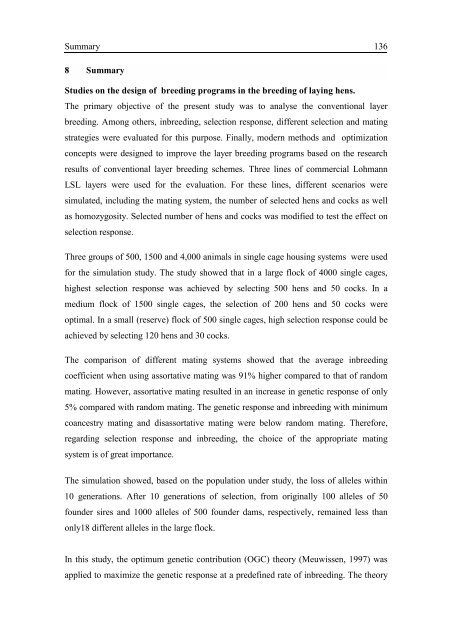tsehay.pdf
tsehay.pdf
tsehay.pdf
Erfolgreiche ePaper selbst erstellen
Machen Sie aus Ihren PDF Publikationen ein blätterbares Flipbook mit unserer einzigartigen Google optimierten e-Paper Software.
Summary 136<br />
8 Summary<br />
Studies on the design of breeding programs in the breeding of laying hens.<br />
The primary objective of the present study was to analyse the conventional layer<br />
breeding. Among others, inbreeding, selection response, different selection and mating<br />
strategies were evaluated for this purpose. Finally, modern methods and optimization<br />
concepts were designed to improve the layer breeding programs based on the research<br />
results of conventional layer breeding schemes. Three lines of commercial Lohmann<br />
LSL layers were used for the evaluation. For these lines, different scenarios were<br />
simulated, including the mating system, the number of selected hens and cocks as well<br />
as homozygosity. Selected number of hens and cocks was modified to test the effect on<br />
selection response.<br />
Three groups of 500, 1500 and 4,000 animals in single cage housing systems were used<br />
for the simulation study. The study showed that in a large flock of 4000 single cages,<br />
highest selection response was achieved by selecting 500 hens and 50 cocks. In a<br />
medium flock of 1500 single cages, the selection of 200 hens and 50 cocks were<br />
optimal. In a small (reserve) flock of 500 single cages, high selection response could be<br />
achieved by selecting 120 hens and 30 cocks.<br />
The comparison of different mating systems showed that the average inbreeding<br />
coefficient when using assortative mating was 91% higher compared to that of random<br />
mating. However, assortative mating resulted in an increase in genetic response of only<br />
5% compared with random mating. The genetic response and inbreeding with minimum<br />
coancestry mating and disassortative mating were below random mating. Therefore,<br />
regarding selection response and inbreeding, the choice of the appropriate mating<br />
system is of great importance.<br />
The simulation showed, based on the population under study, the loss of alleles within<br />
10 generations. After 10 generations of selection, from originally 100 alleles of 50<br />
founder sires and 1000 alleles of 500 founder dams, respectively, remained less than<br />
only18 different alleles in the large flock.<br />
In this study, the optimum genetic contribution (OGC) theory (Meuwissen, 1997) was<br />
applied to maximize the genetic response at a predefined rate of inbreeding. The theory

















